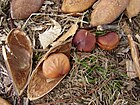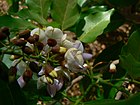Note: This is a project under development. The articles on this wiki are just being initiated and broadly incomplete. You can Help creating new pages.
Pongamia pinnata - Karanjah
Pongamia pinnata is a genus of legume in the fabaceae family. Recently it has been proposed that the genus Pongamia be rejected in favor of the genus Millettia and many species have been reclassified. Due to recent interest in biofuels, Pongamia is often the generic name given for Millettia pinnata, a tree being explored for producing biodiesel.
Uses
Dyspepsia, Skin diseases, Rheumatic joints, Scabies, Bronchitis, Whooping cough, Febrifuge, Bleeding haemorrhoids
Parts Used
Chemical Composition
The metabolities, beta-sitosteryl acetate and galactoside, stigma sterol, its galactoside and sucrose are being reported for the first time from this plant.[1]
Common names
| Language | Common name |
|---|---|
| Kannada | Honge, Hulagilu |
| Hindi | Dithouri, Karuaini |
| Malayalam | Avittal, Ungu, Unu, Pungu |
| Tamil | Pungan, Pongana |
| Telugu | Lamiga, Kanuga |
| Marathi | Karanja |
| Gujarathi | Kanajo, Karanji |
| Punjabi | Karanj |
| Kashmiri | Kath |
| Sanskrit | Karanjaka, Natkamala |
| English | Smooth leaved pongamia |
Properties
Reference: Dravya - Substance, Rasa - Taste, Guna - Qualities, Veerya - Potency, Vipaka - Post-digesion effect, Karma - Pharmacological activity, Prabhava - Therepeutics.
Dravya
Rasa
Tikta (Bitter), Kashaya (Astringent)
Guna
Laghu (Light), Ruksha (Dry), Tikshna (Sharp)
Veerya
Ushna (Hot)
Vipaka
Katu (Pungent)
Karma
Kapha, Vata
Prabhava
Habit
Identification
Leaf
| Kind | Shape | Feature |
|---|---|---|
| Imparipinnate | Ovate-oblong | Leaflets 5-7, opposite, leaflet 4.5-12 x 2-7 cm, margin entire, secondary veins 5 - 8 pairs, pinnate, tertiary veins reticulate, obscure. |
Flower
| Type | Size | Color and composition | Stamen | More information |
|---|---|---|---|---|
| Bisexual | 15-18mm long | Purplish white | 10 | Flowers bisexual, purplish-white, 15-18 mm long, in lax axillary racemes, axis pubescent; bracts small, cauducous. Calyx tube campanulate; minutely 5 toothed, apex truncate; corolla exserted. Petals 5, clawed; standard suborbicular with curved folds above the claw; wings obliquely oblong, slightly adnate above the claws to the obtuse keel petals which are joined near the tip. Stamens 10, monadelphous, the vexillary stamen free below and above; anthers uniform. Ovary subsessile, inferior, 1-celled, ovules 2; style in curved, beardless; stigma capitate. |
Fruit
| Type | Size | Mass | Appearance | Seeds | More information |
|---|---|---|---|---|---|
| Pod | 4-5 x 2-2.5 cm | Obliquely oblong, flat, thick, pointed at both ends, indehiscent, slightly falcate | seed one, reniform. | {{{6}}} |
Other features
List of Ayurvedic medicine in which the herb is used
Where to get the saplings
Mode of Propagation
How to plant/cultivate
Seeds, remaining viable for sometime, require no special scarification. Direct sowing is usually successful. Seedlings transplant easily from the nursery after about a year. Root suckers are rather plentiful as well. It is a rapid-growing coppice species that can be cloned.[3]
Commonly seen growing in areas
Photo Gallery
References
External Links
- Ayurvedic Herbs known to be helpful to treat Dyspepsia
- Ayurvedic Herbs known to be helpful to treat Skin diseases
- Ayurvedic Herbs known to be helpful to treat Rheumatic joints
- Ayurvedic Herbs known to be helpful to treat Scabies
- Ayurvedic Herbs known to be helpful to treat Bronchitis
- Ayurvedic Herbs known to be helpful to treat Whooping cough
- Ayurvedic Herbs known to be helpful to treat Febrifuge
- Ayurvedic Herbs known to be helpful to treat Bleeding haemorrhoids
- Herbs with Dried foliage used in medicine
- Herbs with Whole herb used in medicine
- Herbs with common name in Kannada
- Herbs with common name in Hindi
- Herbs with common name in Malayalam
- Herbs with common name in Tamil
- Herbs with common name in Telugu
- Herbs with common name in Marathi
- Herbs with common name in Gujarathi
- Herbs with common name in Punjabi
- Herbs with common name in Kashmiri
- Herbs with common name in Sanskrit
- Herbs with common name in English
- Habit - Evergreen tree
- Index of Plants which can be propagated by Seeds
- Index of Plants which can be propagated by Cuttings
- Herbs that are commonly seen in the region of Villages
- Herbs that are commonly seen in the region of Cities
- Herbs that are commonly seen in the region of River banks
- Herbs that are commonly seen in the region of Coastal areas
- Herbs
- Fabaceae







